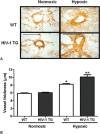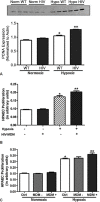Human immunodeficiency virus-1 transgene expression increases pulmonary vascular resistance and exacerbates hypoxia-induced pulmonary hypertension development
- PMID: 23662175
- PMCID: PMC3641741
- DOI: 10.4103/2045-8932.109915
Human immunodeficiency virus-1 transgene expression increases pulmonary vascular resistance and exacerbates hypoxia-induced pulmonary hypertension development
Abstract
Pulmonary arterial hypertension (PAH) is a progressive disease characterized by increased pulmonary arterial resistance and vessel remodeling. Patients living with human immunodeficiency virus-1 (HIV-1) have an increased susceptibility to develop severe pulmonary hypertension (PH) irrespective of their CD4+ lymphocyte counts. While the underlying cause of HIV-PAH remains unknown, the interaction of HIV-1 proteins with the vascular endothelium may play a critical role in HIV-PAH development. Hypoxia promotes PH in experimental models and in humans, but the impact of HIV-1 proteins on hypoxia-induced pulmonary vascular dysfunction and PAH has not been examined. Therefore, we hypothesize that the presence of HIV-1 proteins and hypoxia synergistically augment the development of pulmonary vascular dysfunction and PH. We examined the effect of HIV-1 proteins on pulmonary vascular resistance by measuring pressure-volume relationships in isolated lungs from wild-type (WT) and HIV-1 Transgenic (Tg) rats. WT and HIV-1 Tg rats were exposed to 10% O2 for four weeks to induce experimental pulmonary hypertension to assess whether HIV-1 protein expression would impact the development of hypoxia-induced PH. Our results demonstrate that HIV-1 protein expression significantly increased pulmonary vascular resistance (PVR). HIV-1 Tg mice demonstrated exaggerated pulmonary vascular responses to hypoxia as evidenced by greater increases in right ventricular systolic pressures, right ventricular hypertrophy and vessel muscularization when compared to wild-type controls. This enhanced PH was associated with enhanced expression of HIF-1α and PCNA. In addition, in vitro studies reveal that medium from HIV-infected monocyte derived macrophages (MDM) potentiates hypoxia-induced pulmonary artery endothelial proliferation. These results indicate that the presence of HIV-1 proteins likely impact pulmonary vascular resistance and exacerbate hypoxia-induced PH.
Keywords: chronic hypoxia; human immunodeficiency virus; pulmonary hypertension.
Conflict of interest statement
Figures





References
-
- Centers for Disease Control and Prevention, HIV Surveillance Report: Diagnoses of HIV infection and AIDS in the United States and Dependent Areas. 2010;22
-
- McGoon M, Gutterman D, Steen V, Barst R, McCrory DC, Fortin TA, et al. Screening, early detection and diagnosis of pulmonary arterial hypertension: ACCP evidence-based clinical practice guidelines. Chest. 2004;126:14S–34S. - PubMed
-
- Galie N, Hoeper MM, Humbert M, Torbicki A, Vachiery JL, Barbera JA, et al. Guidelines for the diagnosis and treatment of pulmonary hypertension. Eur Respir J. 2009;34:1219–63. - PubMed
-
- Huang J, Wolk JH, Gewitz MH, Mathew R. Progressive endothelial cell damage in an inflammatory model of pulmonary hypertension. Exp Lung Res. 2010;36:57–66. - PubMed
Grants and funding
LinkOut - more resources
Full Text Sources
Other Literature Sources
Research Materials
Miscellaneous

